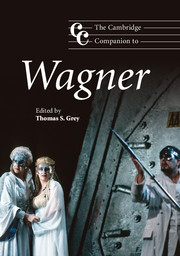Book contents
- Frontmatter
- PART I Biographical and historical contexts
- PART II Opera, music, drama
- 4 The “Romantic operas” and the turn to myth
- 5 Der Ring des Nibelungen: conception and interpretation
- 6 Leitmotif, temporality, and musical design in the Ring
- 7 Tristan und Isolde: essence and appearance
- 8 Performing Germany in Wagner's Die Meistersinger von Nürnberg
- 9 Parsifal: redemption and Kunstreligion
- PART III Ideas and ideology in the Gesamtkunstwerk
- PART IV After Wagner: influence and interpretation
- Notes
- Select bibliography
- Index
7 - Tristan und Isolde: essence and appearance
from PART II - Opera, music, drama
Published online by Cambridge University Press: 28 September 2011
- Frontmatter
- PART I Biographical and historical contexts
- PART II Opera, music, drama
- 4 The “Romantic operas” and the turn to myth
- 5 Der Ring des Nibelungen: conception and interpretation
- 6 Leitmotif, temporality, and musical design in the Ring
- 7 Tristan und Isolde: essence and appearance
- 8 Performing Germany in Wagner's Die Meistersinger von Nürnberg
- 9 Parsifal: redemption and Kunstreligion
- PART III Ideas and ideology in the Gesamtkunstwerk
- PART IV After Wagner: influence and interpretation
- Notes
- Select bibliography
- Index
Summary
When Gerda Buddenbrook presents Edmund Pfühl with piano arrangements of selections from Wagner's Tristan und Isolde, the bookish but genial music-master in Thomas Mann's novel Buddenbrooks shrinks back in horror: “I won't play this, madam. I am your most obedient servant, but I will not play it. That is not music … It is pure chaos! It is demagoguery, blasphemy, and madness! It is a fragrant frog with thunderbolts! It is the end of all morality in the arts. I will not play it!” Eventually he gives in to Gerda's persistent requests, but soon breaks off for fear of the adverse effects the music may have on her impressionable son, Hanno: “And think of the child, the child sitting there in his chair. He stole in quietly to hear music – do you wish to poison his mind for good and all?” As it turns out, Pfühl's concerns are not unwarranted. In the next-to-last chapter of the novel Hanno loses himself in an improvisatory reverie at the keyboard, a fantasy whose climactic passage (with its “unyielding surge,” “chromatic struggle upward,” and “convulsions of desire”) clearly hearkens to the closing pages of Wagner's Tristan (that is, Isolde's “Transfiguration” or Liebestod). The next chapter begins ominously (“Cases of typhoid fever take the following course”) and goes on to recount the early demise of young Hanno Buddenbrook. This final scion of a decaying family, Mann suggests (if not without irony), passes away through and in some sense because of his extended Tristanesque daydreaming.
- Type
- Chapter
- Information
- The Cambridge Companion to Wagner , pp. 115 - 133Publisher: Cambridge University PressPrint publication year: 2008



